| Home | Nature Weekly Index |
10 June 2018 | Thrips and Wild Cherry Plant |
Muntingia calabura is a well-known wild cherry trees in many part of the world including Singapore. I had previously written a note on this tree back in February 2017. It is so prevalence that you get seedlings sprouting out spontaneously in flower pots from time to time. In February this year, I found a few seedlings in my pot. I decided to nurture 2 of them. They grew well as expected and nothing extraordinary happened thus far.
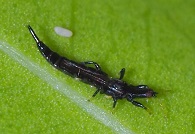
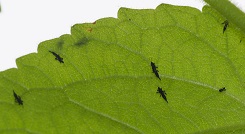
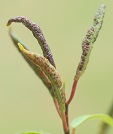 A few weeks back, I relocated one of the pots and placed the young plant next to a pot of
Malayan Banyan (Ficus microcarpa) which also came into
that pot by chance. The Malayan Banyan had been infested with thrips, a small black elongated insect that caused
folding up of the young leaves. A week later, I started to see the tiny black thrips on the leaves and twigs of
the young wild cherry plant. Their migration appeared to increase over time. The logical deduction was that
the thrips were infesting the wild cherry plant as well. Upon closer examination, the unexpected was revealed ---
the thrips were all dead. The sticky surface of the young leaves and twigs of the wild cherry seemed to be toxic
to the thrips.
A few weeks back, I relocated one of the pots and placed the young plant next to a pot of
Malayan Banyan (Ficus microcarpa) which also came into
that pot by chance. The Malayan Banyan had been infested with thrips, a small black elongated insect that caused
folding up of the young leaves. A week later, I started to see the tiny black thrips on the leaves and twigs of
the young wild cherry plant. Their migration appeared to increase over time. The logical deduction was that
the thrips were infesting the wild cherry plant as well. Upon closer examination, the unexpected was revealed ---
the thrips were all dead. The sticky surface of the young leaves and twigs of the wild cherry seemed to be toxic
to the thrips.
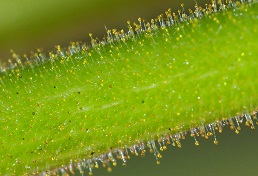
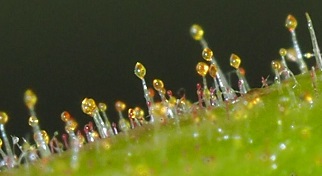 The soft and sticky texture of the surfaces of the leaves and twigs were due to closely packed tiny hairs with
swollen yellowish-tips. Besides the dead thrips, there were also carcases of ants and other tiny insects
floating on these hairs. The way that these hairs operate might be similar to the nectar-tipped tentacles found
in sundews, a group of carnivorous plants.
The soft and sticky texture of the surfaces of the leaves and twigs were due to closely packed tiny hairs with
swollen yellowish-tips. Besides the dead thrips, there were also carcases of ants and other tiny insects
floating on these hairs. The way that these hairs operate might be similar to the nectar-tipped tentacles found
in sundews, a group of carnivorous plants.
A thrips survey in Sri Lanka published in 2011 [1] listed Muntingia calabura as one of the host plants of a thrips known as Thrips hawaiiensis but no other detail was available. In the same report, there was a picture showing a leaf fold damage in Ficus benjamina (Weeping Fig) due to infestation by a thrips (Gynaikothrips ficorum). The thrips in the picture resembled the ones seen on my Malayan Banyan.
The young wild berry plant might be a good sticky trap for unwanted tiny insects such as the thrips. I plan to leave the 2 plants side-by-side for a longer time to observe whether that will help to reduce the thrips population on the Malayan Banyan.
Reference:
[1] Tillekaratne K, Edirisinghe JP, Gunatilleke CVS, Karunaratne WAIP. Survey of thrips in Sri Lanka: A checklist of thrips species, their distribution and host plants. Ceylon J Sci (Bio Sci) 2011;40(2):89-108.